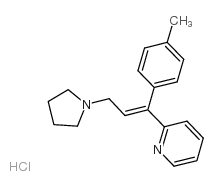CHEMICAL IDENTIFICATION
-
RTECS NUMBER :
-
UT7657000
-
CHEMICAL NAME :
-
Pyridine, 2-(3-(1-pyrrolidinyl)-1-p-tolylpropenyl)-, monohydrochloride, (E)-
-
CAS REGISTRY NUMBER :
-
550-70-9
-
LAST UPDATED :
-
199803
-
DATA ITEMS CITED :
-
8
-
MOLECULAR FORMULA :
-
C19-H22-N2.Cl-H
-
MOLECULAR WEIGHT :
-
314.89
-
WISWESSER LINE NOTATION :
-
T6NJ BYR D1&2- AT5NTJ &GH
HEALTH HAZARD DATA
ACUTE TOXICITY DATA
-
TYPE OF TEST :
-
LD50 - Lethal dose, 50 percent kill
-
ROUTE OF EXPOSURE :
-
Oral
-
SPECIES OBSERVED :
-
Rodent - rat
-
DOSE/DURATION :
-
840 mg/kg
-
TOXIC EFFECTS :
-
Details of toxic effects not reported other than lethal dose value
-
REFERENCE :
-
YAKUD5 Gekkan Yakuji. Pharmaceuticals Monthly. (Yakugyo Jihosha, Inaoka Bldg., 2-36 Jinbo-cho, Kanda, Chiyoda-ku, Tokyo 101, Japan) V.1- 1959- Volume(issue)/page/year: 22,375,1980
-
TYPE OF TEST :
-
LD50 - Lethal dose, 50 percent kill
-
ROUTE OF EXPOSURE :
-
Oral
-
SPECIES OBSERVED :
-
Rodent - mouse
-
DOSE/DURATION :
-
495 mg/kg
-
TOXIC EFFECTS :
-
Details of toxic effects not reported other than lethal dose value
-
REFERENCE :
-
NIIRDN Drugs in Japan (Ethical Drugs). (Yakugyo Jiho Co., Ltd., Tokyo, Japan) Volume(issue)/page/year: 6,525,1982
-
TYPE OF TEST :
-
LD50 - Lethal dose, 50 percent kill
-
ROUTE OF EXPOSURE :
-
Subcutaneous
-
SPECIES OBSERVED :
-
Rodent - mouse
-
DOSE/DURATION :
-
247 mg/kg
-
TOXIC EFFECTS :
-
Details of toxic effects not reported other than lethal dose value
-
REFERENCE :
-
NIIRDN Drugs in Japan (Ethical Drugs). (Yakugyo Jiho Co., Ltd., Tokyo, Japan) Volume(issue)/page/year: 6,525,1982
-
TYPE OF TEST :
-
LD50 - Lethal dose, 50 percent kill
-
ROUTE OF EXPOSURE :
-
Intravenous
-
SPECIES OBSERVED :
-
Rodent - mouse
-
DOSE/DURATION :
-
21 mg/kg
-
TOXIC EFFECTS :
-
Details of toxic effects not reported other than lethal dose value
-
REFERENCE :
-
BJPCAL British Journal of Pharmacology and Chemotherapy. (London, UK) V.1-33, 1946-68. For publisher information, see BJPCBM. Volume(issue)/page/year: 8,171,1953
-
TYPE OF TEST :
-
LD - Lethal dose
-
ROUTE OF EXPOSURE :
-
Intravenous
-
SPECIES OBSERVED :
-
Mammal - dog
-
DOSE/DURATION :
-
>5 mg/kg
-
TOXIC EFFECTS :
-
Behavioral - tremor Behavioral - excitement Lungs, Thorax, or Respiration - dyspnea
-
REFERENCE :
-
BJPCAL British Journal of Pharmacology and Chemotherapy. (London, UK) V.1-33, 1946-68. For publisher information, see BJPCBM. Volume(issue)/page/year: 8,171,1953 *** NIOSH STANDARDS DEVELOPMENT AND SURVEILLANCE DATA *** NIOSH OCCUPATIONAL EXPOSURE SURVEY DATA : NOHS - National Occupational Hazard Survey (1974) NOHS Hazard Code - 81570 No. of Facilities: 842 (estimated) No. of Industries: 2 No. of Occupations: 2 No. of Employees: 990 (estimated) NOES - National Occupational Exposure Survey (1983) NOES Hazard Code - 81570 No. of Facilities: 178 (estimated) No. of Industries: 1 No. of Occupations: 3 No. of Employees: 2378 (estimated) No. of Female Employees: 1467 (estimated)
|




